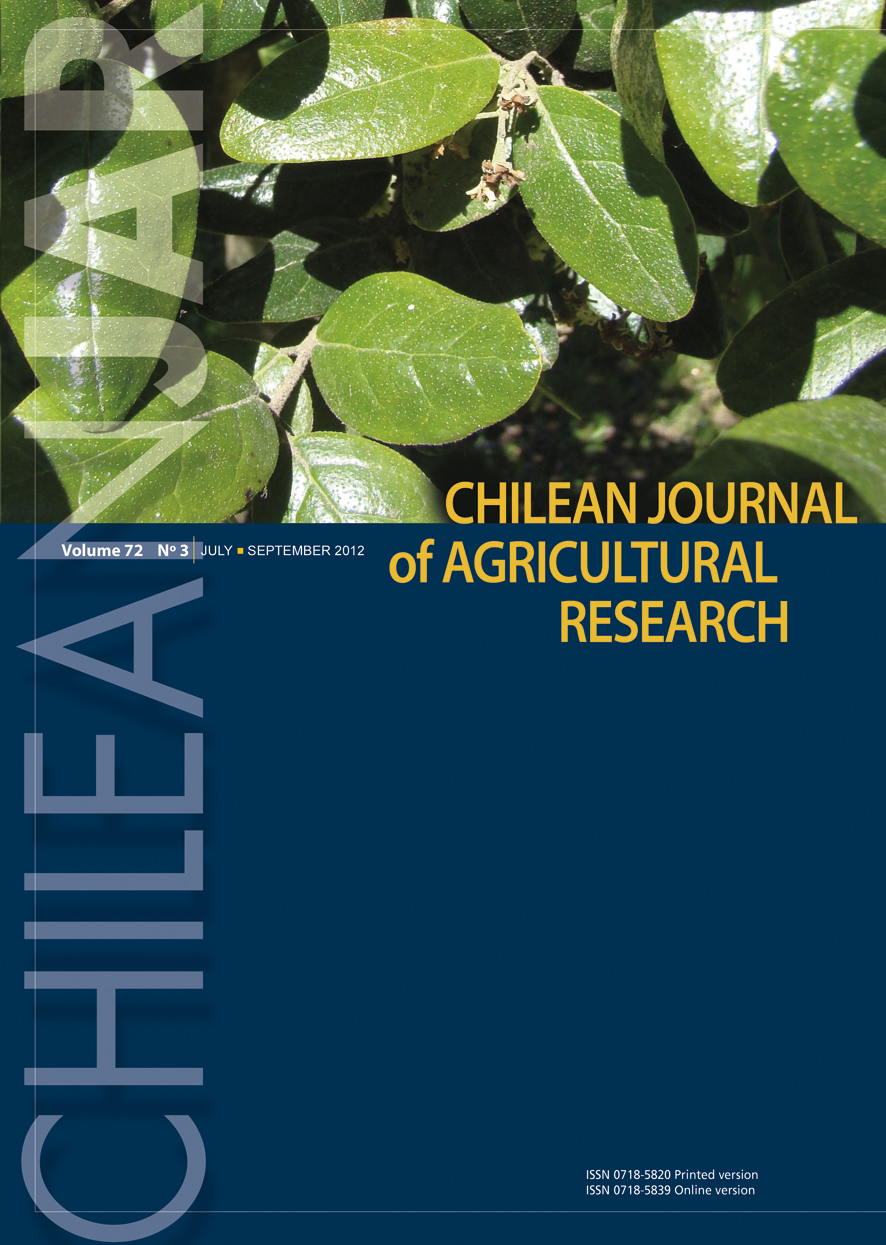
|
Chilean Journal of Agricultural Research
Instituto de Investigaciones Agropecuarias, INIA
ISSN: 0718-5820
EISSN: 0718-5820
Vol. 70, No. 4, 2010, pp. 552-558
|
 Bioline Code: cj10061
Bioline Code: cj10061
Full paper language: English
Document type: Research Article
Document available free of charge
|
|
|
Chilean Journal of Agricultural Research, Vol. 70, No. 4, 2010, pp. 552-558
| es |
Caracterización de la tolerancia al frío en tomate dependiente de las condiciones de luz y temperatura.
Elizondo, Rafael & Oyanedel, Eduardo
Resumen
La resistencia al frío es una característica deseable en cultivares de tomate, entre otras razones para ampliar el período de cultivo y la distribución geográfica. Se evaluaron dos líneas casi isogénicas de tomate, LA3921 y LA 3925 con introgresiones de Solanum habrochaites S. Knapp & D.M. Spooner (especie resistente al frío). Las introgresiones se ubican en los cromosomas 2 y 3. Se establecieron cuatro fechas al aire libre, entre el día juliano 232 y 274 (21 de agosto al 2 de octubre). Se analizó el clima en los períodos evaluados, considerando la suma térmica como horas grados de crecimiento en base 12 °C y horas-frío (bajo 12 °C); la radiación se interpretó como integral de radiación. Se evaluó la tasa de crecimiento relativa en dos períodos sucesivos de 10 d postrasplante, el porcentaje de cuaja y rendimiento. La resistencia al frío se expresó con bajas temperaturas y alta radiación. Esto ocurrió en la fecha de establecimiento del día juliano 257; en el período posttransplante al día 10, ambas NILs presentaron una tasa de crecimiento en área foliar 1,7 veces más alta que el control. Para el segundo período considerado, entre 10 y 20 d postrasplante, ambas NILs crecieron en promedio 1,4 veces más que el control. No hubo diferencias en la precocidad de cosecha, ni en el porcentaje de cuaja. Estas NILs no podrían usarse directamente para obtener resistencia al frío, debido a una baja cuaja de frutos, 84% inferior en LA3921, probablemente causada por un arrastre por ligamiento y por una baja plasticidad ambiental de ambas.
Palabras-clave
arrastre por ligamiento, Solanum habrochaites, NILs.
|
| |
| en |
Field Testing Of Tomato Chilling Tolerance Under Varying Light And Temperature Conditions
Elizondo, Rafael & Oyanedel, Eduardo
Abstract
Chilling tolerance is a desirable trait in commercial tomato varieties, in order to extend the growing season and geographic range. Two Nearly Isogenic Lines (NILs) with introgressions in chromosome 2 and 3 of Solanum habrochaites S. Knapp & D.M. Spooner, a cold-resistant wild tomato, were evaluated in the field. Four plantings were established between 21 August and 2 October 2006 (day 232 and 274). Throughout the experiment the heat sum was interpreted using air temperature to calculate growing degree days (base 12 °C) and chilling hours (below 12 °C), with the daily light integral calculated as global solar radiation. The relative post-transplant growth rate, fruit set and yield, were evaluated over two successive 10-d periods. Chilling tolerance is expressed under high radiation and low temperature conditions, which occurred during the 10-d post-transplant evaluation period beginning on day 257, when both NILs achieved a leaf area growth rate 1.7 times higher than the control plants. During the second evaluation period, 10-20 d post-transplant, both NILs grew on average, 1.4 times more than the control. There were no significant differences in earliness or fruit set. These NILs should not be used as a direct source to obtain chilling tolerant varieties, because of the low fruit set, 84% lower in LA3921 than the control, probably due to linkage drag and poor environmental adaptability in both lines.
Keywords
Linkage drag, Solanum habrochaites, NILs.
|
| |
© Copyright 2010 Chilean Journal of Agricultural Research.
Alternative site location: http://www.inia.cl
|
|
